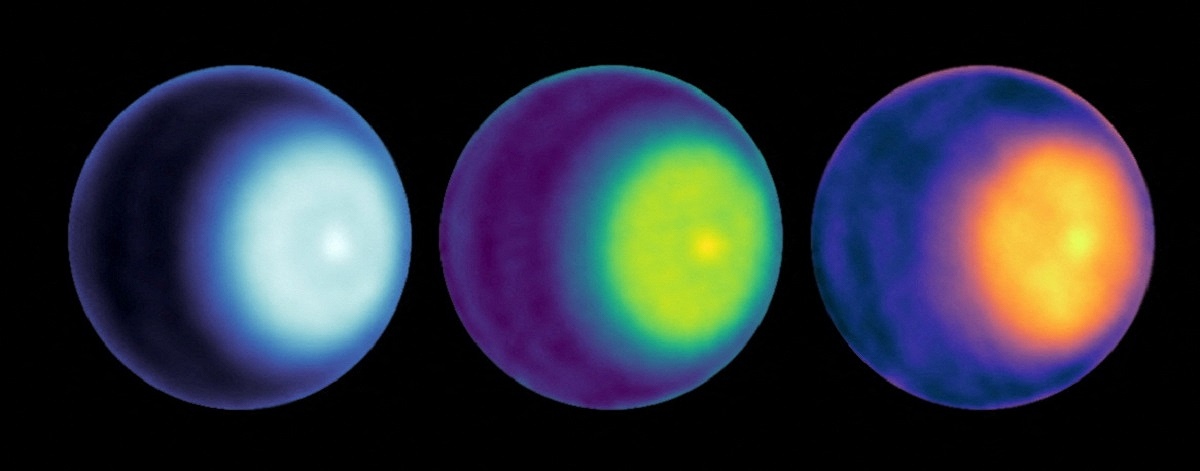
NASA scientists use microwave observations to spot the first polar cyclone on Uranus, seen here as a light-colored dot to the right of center in each image of the planet, in this image released on May 25.
14:02 JST, June 3, 2023
WASHINGTON (Reuters) — It is a world wrapped in mystery — the seventh planet from the sun, Uranus, seen up close just once nearly four decades ago by a passing NASA probe and still warily guarding its secrets.
But new observations from a telescope located in New Mexico are providing a fuller understanding of its atmosphere, including the detection of a polar cyclone whose center measures a quarter of Earth’s diameter, swirling near its north pole.
Scientists were able to gaze more deeply into the atmosphere of Uranus — a planet classified as an ice giant, like its planetary neighbor Neptune — than ever before. The findings painted a picture of a planet more dynamic than previously known.
“While the general makeup of its atmosphere and interior are similar to Neptune — as far as we know — Uranus has some pretty unique features,” said planetary scientist Alex Akins of NASA’s Jet Propulsion Laboratory in California, lead author of the research published in the journal Geophysical Research Letters.
“It spins on its side. And even then, its magnetic field is still misaligned with its rotational axis. The atmospheric circulation and internal heat release appear weaker than Neptune, but there are still a range of dynamical features and storms that have been observed,” Akins added.
Uranus, blue-green in color due to the methane contained in an atmosphere comprised mostly of hydrogen and helium, is the third-largest planet in our solar system. It has a diameter of about 50,700 kilometers and is big enough to fit 63 Earths inside it. Uranus orbits the sun at a distance of about 2.9 billion kilometers, almost 20 times further than Earth does. One orbit lasts 84 years.
Its unusual tilt makes Uranus appear to orbit the sun like a rolling ball.
The researchers used the Very Large Array telescope in New Mexico to see below the clouds at the top of the atmosphere, finding circulating air at the north pole that was warmer and drier, evidence of a strong cyclone. They were able to estimate the size of the storm’s center but not the entire cyclone’s diameter, though it potentially could be wider than Earth.
The research confirmed that polar cyclones are present on every body in our solar system with a substantial atmosphere — all the planets but Mercury and even Saturn’s moon Titan.
“Polar cyclones are regions of high winds moving in a direction determined by the planet’s rotation — clockwise on Venus, Uranus and anticlockwise for the rest — with differing air properties between the inside and out,” Akins said.
“The way they form is different from planet to planet,” Akins added. “On Earth, their strength is modulated by season due to the amount of sunlight. We aren’t quite sure yet how they form on Uranus. It’s different from other cyclones in the sense that it’s generally longer-lived and most likely forms from a different balance of atmospheric processes, and therefore is a more characteristic [enduring] feature of the atmosphere. That is unlike hurricanes, which form, move and dissipate on relatively short time scales.”
Most of the mass of Uranus is a dense fluid of icy materials — water, methane and ammonia. Uranus is surrounded by two sets of faint rings and orbited by 27 small moons. Its atmosphere is the coldest of any of the eight planets, including outermost Neptune.
Its only close encounter with a spacecraft came when Voyager 2 flew by in 1986.
“There are a lot of unknowns,” Akins said. “How did it get tilted on its side? Is its interior really ‘icier’ than the gas giants [Jupiter and Saturn]? Why do we see atmospheric banding features that aren’t aligned with the measured wind speeds? Why is the pole so much drier than the equator? Are its satellites [moons] ocean worlds?”
"Science & Nature" POPULAR ARTICLE
-

Mass Oyster Die-Offs Confirmed in Japan’s Seto Inland Sea; High Water Temperature Cited as Primary Cause
-

Researchers in U.S., Japan Offer Insight into Ghostly Neutrinos
-

Big Leap in Quest to Get to Bottom of Climate Ice Mystery
-

Security Camera Footage Vulnerable to Outside Access; Investigation Finds 3,000 Pieces Exposed Online
-

Japan Plans to Develop System of AI Evaluating Credibility of Other AI Models
JN ACCESS RANKING
-

Govt Plans to Urge Municipalities to Help Residents Cope with Rising Prices
-

Japan Prime Minister Takaichi Vows to Have Country Exit Deflation, Closely Monitor Economic Indicators
-

Japan to Charge Foreigners More for Residence Permits, Looking to Align with Western Countries
-

Japan GDP Down Annualized 1.8% in July-Sept.
-

JR East Suica’s Penguin to Retire at End of FY2026; Baton to be Passed to New Character
























